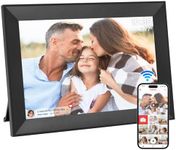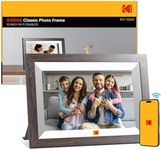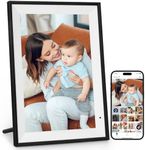Buying Guide for the Best Digital Photo Frame Uk
Choosing the right digital photo frame can be a delightful experience, as it allows you to display your cherished memories in a modern and dynamic way. When selecting a digital photo frame, it's important to consider several key specifications to ensure you get the best fit for your needs. Here are the main aspects to look at and how to navigate them.Screen SizeScreen size refers to the diagonal measurement of the display area. This is important because it determines how large your photos will appear. Smaller frames (7-8 inches) are great for desks or small spaces, while medium frames (10-12 inches) are versatile for most home settings. Larger frames (over 12 inches) are ideal for living rooms or areas where you want a more prominent display. Choose a size that fits the space where you plan to place the frame and how visible you want the photos to be.
ResolutionResolution indicates the number of pixels on the screen, affecting the clarity and detail of the images. Higher resolution means sharper and more detailed pictures. Common resolutions include 800x600 for basic clarity, 1024x768 for better detail, and Full HD (1920x1080) for the best quality. If you want crisp and clear images, especially on larger screens, opt for higher resolutions. For smaller frames, lower resolutions might suffice.
Storage CapacityStorage capacity determines how many photos the frame can hold. This can be internal memory or expandable via SD cards or USB drives. Frames with 2GB to 8GB of internal storage can hold hundreds to thousands of photos, depending on file size. If you have a large photo collection or want to frequently update the display, consider frames with expandable storage options. Think about how often you want to change the photos and how many you want to display at once.
ConnectivityConnectivity options include Wi-Fi, Bluetooth, and USB ports. Wi-Fi-enabled frames can receive photos directly from your smartphone or email, making it easy to update images remotely. Bluetooth allows for quick transfers from nearby devices. USB ports and SD card slots are useful for transferring photos directly from your camera or computer. Choose a frame with connectivity options that match your tech habits and how you prefer to transfer and update photos.
Aspect RatioAspect ratio is the proportional relationship between the width and height of the display. Common ratios are 4:3 and 16:9. A 4:3 ratio is closer to the shape of most digital photos and will display them without much cropping. A 16:9 ratio is wider and better for landscape-oriented images or videos. Consider the typical orientation of your photos and choose an aspect ratio that will display them without distortion or excessive cropping.
User Interface and FeaturesThe user interface and additional features can greatly affect your experience. Look for frames with intuitive controls, either through touchscreens, remote controls, or mobile apps. Features like slideshow modes, transition effects, and the ability to play videos or music can enhance the viewing experience. Think about how you want to interact with the frame and what additional functionalities you might enjoy.
Design and Build QualityDesign and build quality refer to the aesthetic and durability of the frame. Frames come in various styles, from modern to classic, and materials like plastic, metal, or wood. Choose a design that complements your home decor. Build quality is also important for longevity, so look for sturdy frames that can withstand regular use. Consider where you will place the frame and choose one that fits your style and is built to last.
















